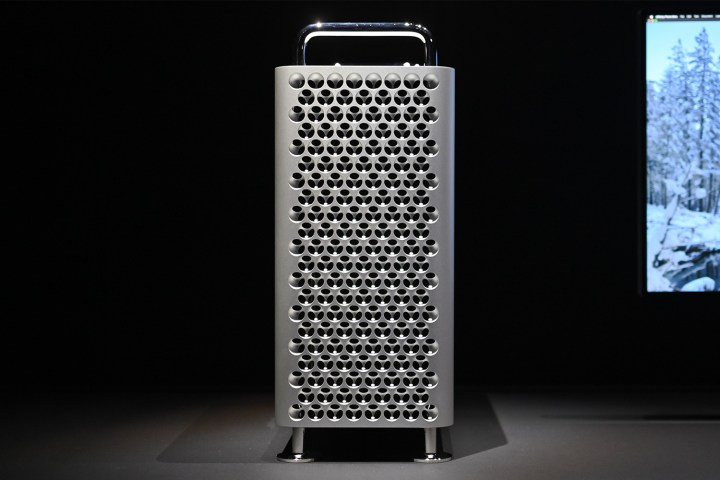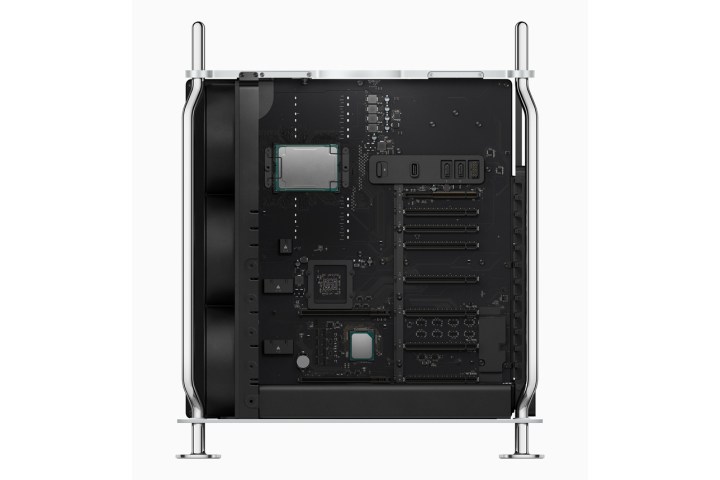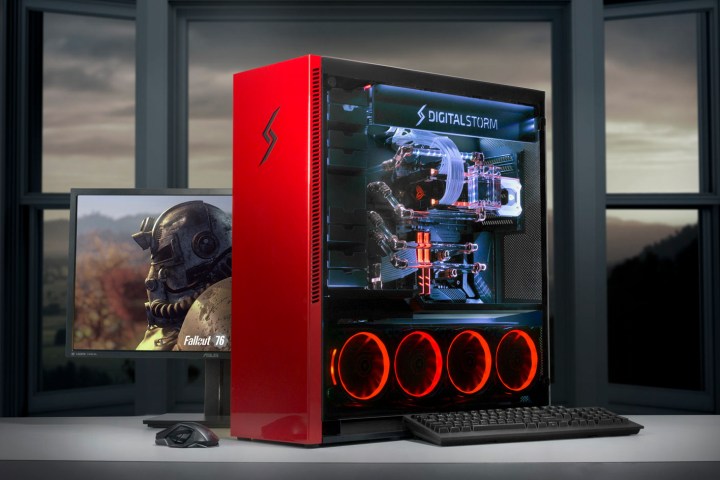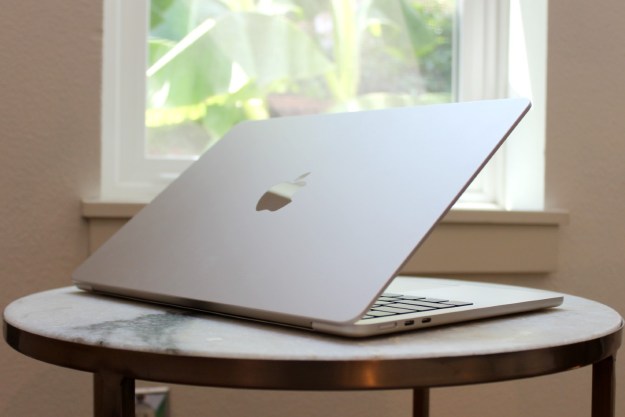
When Apple announced the price of its new Mac Pro at WWDC, people balked. With a $6,000 starting price, it’s not hard to see why.
But, how overpriced is it really? It’s always difficult to compare a Windows PC with an Mac apples-to-apples, especially since we don’t yet know exactly how the Mac Pro’s configurations will price out. But going piece by piece, will you realistically be able to get more power and expandability in a PC you buy or build for far less money? The answer isn’t as simple as you might think.
The power in the tower
Let’s start with the size of the case itself. With a return to the tower form, this year’s Mac Pro is a modern remake of the first-generation Apple pro desktop that preceded the transition to last year’s trash can design. With a completely removable aluminum enclosure that provides 360-degree access to the internals, Apple promises a design that’s modular, serviceable, and upgradeable, providing users with years of use.
Those are traits in which a traditional desktop PC excels. However, the footprint-to-power ratio the Mac Pro aims for might be something new.
The Mac Pro has increased in footprint, growing from an 11-pound canister to a 40-pound tower.
To accommodate its new design, the Mac Pro has increased in footprint, growing from an 11-pound canister to a 40-pound tower. Measuring 20.8 × 17.7 × 8.58 inches, the Mac Pro is one of the most compact desktops you can buy today that supports quad-graphics. How do some of the familiar faces in the world of high-powered gaming PCs stack up?
Well, the Mac Pro weighs more than double the 18-pound Origin Neuron, which comes in a more compact body. HP’s similarly-sized Omen Obelisk measures 23 pounds, while Alienware’s Aurora R8 gaming desktop adds a top carry handle to its more bulbous 32-pound chassis. Though these PC competitors may be more compact and lighter than Apple’s flagship computing powerhouse, all of these Windows 10-powered systems have some serious limitations compared to the Mac Pro in terms of performance expandability. Most notably, you’re limited to dual-graphics and fewer opportunities for PCIe expansion.

To match the quad-GPU support of the Mac Pro, you’ll likely need to upgrade to a far larger desktop on the Windows side, like Digital Storm’s Aventum X. The boxy Aventum X, for comparison, starts at 75 pounds and comes measuring 25.7 × 28.3 × 10 inches, and its wheel-less design makes it difficult to move. For graphical power you get in the Mac Pro’s size, it’s in a league of its own.
$6K silicon
The base Mac Pro starts at $6,000, and even at this price, it will be priced out reach for most people. Creative professionals, however, will find plenty to love with an Intel Xeon W processor, 32GB RAM, AMD Radeon Pro 580X GPU, a massive 1.4-kilowatt power supply, Apple’s custom Afterburner ASIC card, 256GB SSD encrypted with T2 security chip, and eight available PCIe slots.
Some have estimated that a fully configured Mac Pro will cost upwards of $35,000.
Not all of that can be replicated in any one Windows PC, but let’s start with the processor. The star of the show this year is Intel’s Xeon W silicon, a workstation-class processor with an insane amount of cores for intense multithreaded performance.
Though Apple hasn’t revealed the specific Xeon part it uses in the base configuration, Intel lists a comparable Cascade Lake W 3.5GHz Xeon W processor with 66.5MB of memory for $749. Similarly, at the high-end, Intel lists a comparable 28-core 2.5GHz Xeon W 3275M at $7,453, though this chip comes with less cache than the processor specified by Apple on its fully specced desktop.
Some have estimated that a fully configured Mac Pro will cost upwards of $35,000 based on parts alone, making the processor one-fifth of this workstation’s overall price.
Right now, Intel’s latest Cascade Lake W Xeon chipsets aren’t shipping in any workstation, and even the Mac Pro isn’t due out until fall. Most pre-built gaming PCs come with Intel’s Core i9 processor, like the eight-core Core i9-9900K on HP’s Omen Obelisk or the upgraded $2,000 9980XE variant with 18 cores. Core for core, the Mac Pro’s processor performance isn’t too hard to replicate. In fact, if you need more processing power, workstations from Dell, HP, and Lenovo can even be equipped with a dual-CPU setup, something that isn’t supported on the Mac Pro.
Boosted graphics
Discrete graphics on the Mac Pro start with AMD’s Radeon Pro 580X GPU. Even though the Radeon 580X isn’t a new part — it’s been available on the recent iMac 5K — AMD doesn’t sell this chip as a standalone part. On the iMac, we found 1080p gaming performance to be mediocre, and creatives will likely want to make the jump to better Vega II graphics. On the PC, performance of Nvidia’s mid-range $499 RTX 2070 graphics in just about any system will outdo the Radeon Pro.
For example, in the same $6,000 range as the Mac Pro, Origin PC’s Neuron should hold up far better than the Radeon 580X. You’ll have to make do with a weaker Intel Core i9 9980XE processor, but you’ll get two Nvidia RTX 2080 Ti graphics cards, while matching Apple’s storage capacity and doubling the amount of memory. Even a single RTX 2080 Ti card will be more capable for rendering, video editing, and 3D modeling than the base Radeon Pro GPU in the base model of the Mac Pro.

For pro-grade graphics, you can even upgrade to Nvidia’s $2,500 Titan RTX card. PC builders can pair this card with the Intel Core i9-9900K processor to save money and get even stronger GPU performance. In the base model, your typical gaming PC has the Mac Pro beat.
On the high-end Mac Pro, Apple offers a quad-graphics solution consisting of two dual-AMD GPUs. The AMD Radeon Pro Vega II comprises two GPUs, each connected via Apple’s proprietary Infinity Fabric Link connector inside Apple’s proprietary MPX box. For quad-graphics, you can use two of these modules, which make up the AMD Pro Vega II Duo.
The Aventum X is one of a few pre-built PCs that can match the quad-GPU support on the Mac Pro.
During its WWDC keynote, Apple claimed that Maxon is able to achieve 20% faster GPU rendering performance on Cinema 4D than on a Windows system maxed out with three of the latest Nvidia Quadro cards, but that might be an unfair comparison since the Mac Pro is technically equipped with four AMD graphics cards.
The Aventum X is one of a few pre-built PCs that can match the quad-GPU support on the Mac Pro, and it comes in at a hefty $36,000 price when configured with a 28-core 3.1GHz Intel Xeon W-3175 processor, 512GB DDR4 memory, 1,600-watt power supply, 4TB solid-state storage divided into two-2TB Samsung 970 EVO M.2 cards, and four Nvidia GeForce RTX 2080 Ti graphics cards with NVLink connector. Even at this price, the Aventum X still can’t match some of the Mac Pro’s specs, falling short on RAM and lacking the ability to add an ASIC card.
Designed for future expansion
Where the Mac Pro shines is with its eight PCIe slots and Thunderbolt 3 support. Most pre-built PCs commonly ship with four or five PCIe slots, limiting expansion capabilities.
Even the Aventum X supports only four PCIe slots despite its much larger size. So, while this PC can accommodate four graphics cards, you won’t be able to add anything else, like Apple’s custom application specific integrated circuit Afterburner card, which is used for video and rendering. Even though Digital Storm offers high performance computing processors to achieve a similar function, you’ll have to make trade-offs with the number of GPUs to fill the four PCIe slots.

When configured with dual-Nvidia Titan RTX graphics and two Nvidia GPGPU ASIC processors, and 512GB RAM, the cost of the Aventum X creeps into BMW’s luxury 4 series price territory.
DIY PC builders looking to match the Mac Pro’s expandability will need to find both a motherboard and a case that supports that many PCIe slots. One case that can support eight slots is One Stop System’s $3,795 Cube 3. This means that PC builders at home can expect to spend in the area of $5,000 for the case, base Xeon processor, AMD Radeon Pro 580X graphics, and power supply — and that’s not including the fans, memory, Thunderbolt 3 support, or SSD.
Memory and storage for days
It’s easy to find a PC that supports the Mac Pro’s starting 32GB of RAM, but it’s nearly impossible to find one that ships with 1.5TB of memory as the fully configured model. With 1.5TB of RAM, the Mac Pro is entering server territory, and Apple even announced a rack-mounted case for this purpose. A single stick of 128GB DDR4 ECC RAM is priced at $1,500, and the Mac Pro has 12 DIMM slots for a total cost of $18,000.
Very few PCs can ship with more than 1.5TB of memory.
Though the 64-bit versions of Windows 10 can support up to 2TB of RAM — Windows 10 Pro for Workstations goes even further. As an insightful reader pointed out, it can be configured with up to 6TB. That’s four times the maximum memory on the Mac Pro — though most PC workstations today don’t ship with anything close to that number out of the box.
Options such as the Lenovo Thinkstation 920 can only be configured to ship with a total of 512GB of RAM with its 16 DIMM slots, while HP’s top-of-the-line model factory configuration tops out with 768GB of memory for a premium of nearly $30,000. Dell’s Precision workstation was the only workstation that can be configured with more RAM than the Mac Pro, with the option to go to 3TB — with 128GB sticks occupying 24 DIMM slots — for a total premium of more than $90,000.
Storage on the Mac Pro ranges between one 256GB solid-state drive or a 4TB of combined storage divided between two SSDs. The Mac Pro’s storage is not hard to beat on the PC side, with some workstations supporting ten storage bays for even more capacity. Even on the Neuron, you can have one main 4TB Samsung 860 Pro SSD, along with four additional 4TB SATA III SSDs to maximize storage, or switch to NVMe drives for even faster performance but with some tradeoff in capacity. Even though storage options are limited on the Mac Pro, you should be able to quickly swap in a larger drive or augment your existing storage with a Thunderbolt 3 drive.
Though the Mac Pro promises to be an insanely powerful tool that will satiate the needs of creatives, the base model seems a bit underwhelming — 256GB of storage is paltry, and the performance of AMD’s Radeon Pro 580X graphics doesn’t hold up well for a pro-class desktop — especially for its $6,000 price.
On the higher end of the spectrum, it’s difficult to replicate the Mac Pro experience in any PC today. The closest thing you can get is a workstation PC such as Dell’s Precision 7920, with its impressive dual-CPU and quad-GPU architecture, though it’s a system that maxes out at over $150,000. Again, without having official pricing about the higher-end configurations of the Mac Pro, it’s hard to make a direct comparison.
There are, however, some elements that Apple hopes can’t be replicated elsewhere. The custom Afterburner card makes it faster to edit and render video, eight PCIe slots make for a serious amount of expandability, and by shipping the Mac Pro with up to 1.5TB of RAM fully configured, Apple has made the Mac Pro a workstation computer that speaks directly to the audience it’s been made for.
Updated on 6/6 to reflect an error in the original post about RAM limitations in Windows and add some comparisons to some available workstation PCs.
Editors' Recommendations
- Does your Mac need antivirus software in 2024? We asked the experts
- Don’t download the latest macOS Ventura update just yet
- I was wrong about using Stage Manager on Mac
- Why you should buy a MacBook Pro instead of a MacBook Air
- Apple just announced the dates for WWDC 2024


